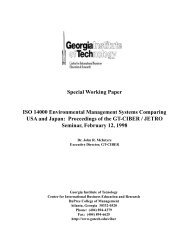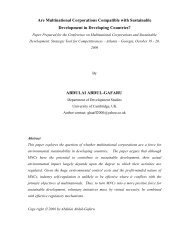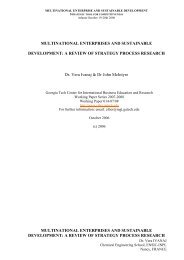AMD vs Intel: Technology, Competition, and Sustainability
AMD vs Intel: Technology, Competition, and Sustainability
AMD vs Intel: Technology, Competition, and Sustainability
Create successful ePaper yourself
Turn your PDF publications into a flip-book with our unique Google optimized e-Paper software.
There has been an implicit live-<strong>and</strong>-let-live conspiracy between the giant firms of<br />
the semiconductor industries. They are associated in the ITRS. Thous<strong>and</strong>s of employees<br />
exchange information about company plans <strong>and</strong> what they are working on. The CEO’s<br />
are very open about their plans when interviewers ask pointed questions about products<br />
<strong>and</strong> technology. Ruthless competition is inconsistent with the widespread practice of<br />
cross licensing. Workers come <strong>and</strong> go, <strong>and</strong> not all of them are diligent in avoiding<br />
conflict of interest between employers. In an unregulated industry like semiconductors,<br />
an innovator needs as second source because a canny customer will not willingly lock<br />
himself into a single supplier to form an indeterminate bilateral monopoly. <strong>Competition</strong><br />
that results from quality or performance improvement is welcome since most<br />
semiconductors are routine, low margin, products. Profits require that someone innovate,<br />
i.e. make something new, <strong>and</strong> someone else authenticate the innovation by licensing it<br />
from the innovator. Innovations tend to come in bunches.<br />
One example of contemporary innovation is the 2B1 computer, developed by<br />
Nicholas Negroponte of the MIT Media Lab <strong>and</strong> the OLPC not-for-profit. OLPC means<br />
“one laptop per child.” The screen is 7.5 1200 x 900 pixel TFT self-refreshing display<br />
with 200 dpi resolution. It has a color mode ( 1 W.), <strong>and</strong> a high-resolution reflective<br />
mode that can be read in sunlight (0.2 w.). Total power is 2-3 W. It has an eight-hour<br />
battery, <strong>and</strong> it can be recharged by a h<strong>and</strong>-powered crank. It has internal video/still<br />
camera, internal speakers with stereo line-out jack, microphone, two USB 2.0 slots, SD<br />
flash slot, 400 MHz <strong>AMD</strong> Geode processor with 128 MB SLC NAND flash on board,<br />
double wide touch pad <strong>and</strong> Linux, communication facilities, OS <strong>and</strong> other custom opensource<br />
software. All users will be able to tie into their neighbors <strong>and</strong> everyone will be<br />
able to sign onto the Internet. The initial price for the 2B1 will be about $140, but the<br />
sponsors hope that the price will fall to about $50 in time. Nigeria has already ordered<br />
one million of them. Libya has agreed to spend $250 million to buy 2B1s for all Libyan<br />
kids. There does not seem to be any coordinated program for integration of these<br />
computers into the schools. Rather the inborn desire to hack computers will have them<br />
downloading music, movies, <strong>and</strong> pornography in the first few hours they get their h<strong>and</strong>s<br />
on them.<br />
<strong>Intel</strong> has a gr<strong>and</strong>iose 5-year plan, called “World Ahead.” <strong>Intel</strong> hopes to introduce<br />
the “Eduwise” computer at $250, although $200 is the ultimate target. They will be<br />
serious full-powered machines, interconnected <strong>and</strong> on the Internet. <strong>Intel</strong> has pledged $1<br />
billion over five years to train 10 million teachers in using computers in the class room,<br />
to teach 1 billion students to use computers in their education. <strong>Intel</strong> is contributing<br />
100,000 computers for classroom in developing countries.<br />
If either or both of these systems actually improve education in remote third<br />
world villages, they will revolution education. Dem<strong>and</strong> will grow without limit until<br />
ultimately everyone will get a laptop when first they go to school. <strong>Intel</strong> has pronounced<br />
Ball State University the most computerized campus, <strong>and</strong> the average student spends<br />
more than 20 hours on-line. When one considers how slow, hot, heavy, awkward, shortlived<br />
<strong>and</strong> inconvenient today’s computers are, it is easy to recognize that computers will<br />
have to be markedly improved if most students are to accept them. <strong>Intel</strong> <strong>and</strong> MIT are not<br />
selling existing computers, but re-inventing them. Kids will put up with today’s laptops if<br />
10















